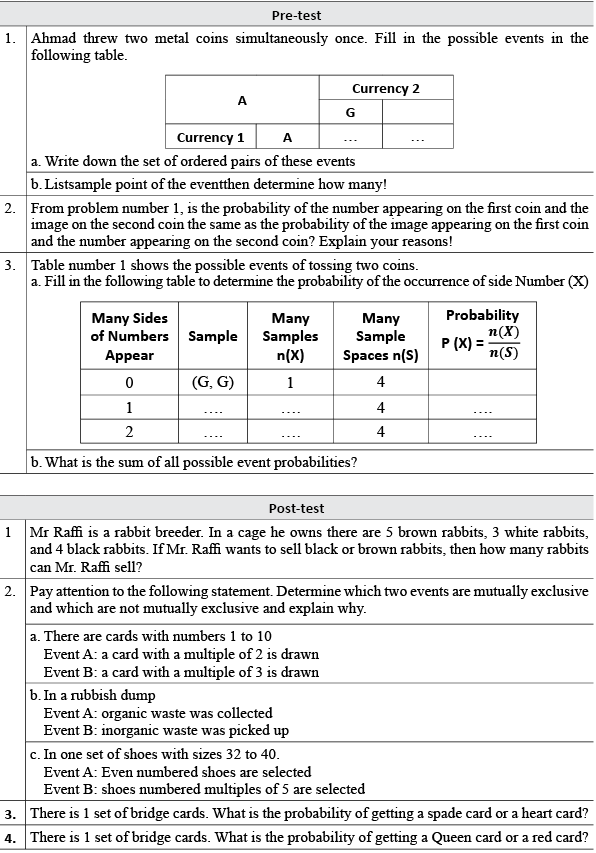 (1)
(1)Acta Paedagogica Vilnensia ISSN 1392-5016 eISSN 1648-665X
2024, vol. 52, pp. 93–110 DOI: https://doi.org/10.15388/ActPaed.2024.52.10
Dewi Oktaviani
Mathematics Education, Yogyakarta State University, Indonesia
E-mail: dwoktvn@gmail.com
Susilo Satanti
Senior High School 5 Surakarta, Indonesia
Abstract. Industry 4.0 era is characterized by the development of technology and the existence of flexible and effective data exchange. This has an impact on the emergence of new jobs that require the ability to solve problems effectively and efficiently, especially computational thinking. This Classroom Action Research aims to improve students’ computational thinking (abstraction, data collection, data analysis and algorithms) in solving problems about probability through problem-based learning integrated with differentiation learning. This research was conducted in four stages: planning, implementation, observation, and reflection. Thirty-four students of class X-E7 SMA Negeri 5 Surakarta in Indonesia were the subjects of this research. It was concluded that the application of problem-based learning model integrated with differentiated learning (content and process) significantly improves students’ computational thinking skills and promotes cognitive development through problem-solving activities. The improvement of computational thinking ability is caused by: data collection activities in the form of dice/coin simulations, abstraction activities of sample points and important information in the problem, activities to formulate solution steps (algorithms) and data analysis activities in the form of interpretation of results and calculations. Differentiated learning (content and process) plays a role in improving students’ computational thinking through ability-based scaffolding and content based on their interests and learning modalities.
Keywords: problem-based learning, differentiated learning, computational thinking.
Santrauka. Pramonės 4.0 erai būdinga technologijų plėtra bei lankstūs ir veiksmingi duomenų mainai. Tai leidžia kurti naujas darbo vietas, kurioms reikia gebėjimo efektyviai ir veiksmingai spręsti problemas, o ypač – informatinio mąstymo gebėjimo. Šiuo klasės veiklos tyrimu siekiama pagerinti mokinių informatinį mąstymą (abstrahavimą, duomenų rinkimą, duomenų analizę ir algoritmų sprendimą) sprendžiant tikimybių uždavinius taikant probleminį ir diferencijuotą mokymąsi. Tyrimas buvo vykdomas keturiais etapais: planavimo, įgyvendinimo, stebėjimo ir refleksijos. Tyrimo dalyviai – trisdešimt keturi Surakartos miesto (Indonezija) valstybinės vidurinės mokyklos X-E7 klasės mokiniai. Tyrimo išvada tokia – probleminio ir diferencijuoto mokymosi (turinio ir proceso) taikymas reikšmingai pagerina mokinių informatinio mąstymo įgūdžius ir skatina kognityvinį vystymąsi sprendžiant įvairias užduotis. Geresnius informatinio mąstymo gebėjimus lemia tokia veikla: duomenų rinkimas, pasitelkiant žaidimus su kauliukais / monetomis, pateikiamų pavyzdžių ir uždaviniams svarbios informacijos abstrahavimas, sprendimo žingsnių (algoritmų) formulavimas bei rezultatų interpretavimas ir skaičiavimas ( duomenų analizė). Diferencijuotas mokymasis (turinys ir procesas) labai svarbus gerinant mokinių informatinį mąstymą, nes jame integruojami individualūs mokinių gebėjimai ir mokymo turinys, kuriuo atsižvelgiama į mokinių interesus ir mokymosi būdus.
Pagrindiniai žodžiai: probleminis mokymasis, diferencijuotas mokymasis, informatinis mąstymas.
_______
Received: 02/11/2023. Accepted: 20/05/2024
Copyright © Dewi Oktaviani, Susilo Satanti
Nowadays, the world is entering the industry 4.0 era, which is characterized by technological developments and flexible and effective data exchange (Oztemel & Gursev, 2020). In the environment of industry 4.0, industrial robots, automated vehicles, and digital applications can replace humans in some activities such as e-commerce (Ghobakhloo, 2020). New job opportunities will be created because of the need to implement industry 4.0, which requires new skills, especially digital capabilities (Grenčíková et al., 2021). Digital capabilities help humans manage, store, analyze and even predict how things will be. There is a strong relationship between digital capabilities and the development of computational thinking skills. Computational thinking skills are the way humans think about solving problems (Wing, 2010). It enables humans to approach problems logically and systematically, analyze data effectively and work with advanced technologies such as artificial intelligence and machine learning (Udvaros et al., 2023). Thus, computational thinking skills are needed for millennials to adjust to the industry 4.0 era.
PISA 2022 recognizes the need for students to understand computational thinking concepts through learning mathematics (OECD, 2020). Not only reading, writing and arithmetic become basic skills, but computational thinking is also necessary (Román-González et al., 2017). In Indonesia, computational thinking has been explicitly integrated in elementary school mathematics learning through the prototype curriculum and is implicitly expected to be integrated in the middle and high school mathematics learning (Liem, 2021). The reason is that computational thinking can help students to solve mathematical problems, one of them is related to probability (Maharani et al., 2019). The application of computational thinking in teaching probability according to Benakli et al. (2017) is to simulate a sample from the distribution of random variables and calculate the probability based on the sample obtained. Through problems of probability, several concepts of computational thinking can be implemented, including data collection, data analysis, data abstraction, and algorithms and procedures (Barr & Stephenson, 2011).
Based on the importance of computational thinking in problem solving, the students of class X-E7 SMA Negeri 5 Surakarta do not yet have good computational thinking skills so there is a need for effort to improve it. According to the results of the questionnaire identification of learning difficulty problems, students have difficulty in solving contextual problems (44.4%). Similar to the questionnaire, the researcher took a pre-test of the probability material to see the students’ difficulties. Based on the pre-test results, students have difficulty in collecting data related to sample points and sample spaces. This difficulty is reinforced by the questionnaire results that 40.7% of students have difficulty in reading data, symbols and others. This difficulty then affects their ability to abstract the information related to sample point data and sample space. In addition, the questionnaire results also show that 33% of students have difficulty in calculations, thus identifying problems in data analysis. Difficulties in data analysis are reinforced by the questionnaire results that 48.1% of students have difficulty in understanding concepts. In addition to the problem of students’ computational thinking skills, there is a very visible gap in the mathematical abilities of female and male students. Female students in class X-E7 have low to high mathematical abilities, where the majority are at medium level. Meanwhile, male students in class X-E7 have medium to low mathematics abilities where the majority are at low level.
Several scholarly works emphasize the significance of CT skills in education. Papert’s constructivist theory laid the groundwork by advocating for hands-on, experiential learning to enhance CT skills through tools like Logo programming (Lodi & Martini, 2021). Resnick’s work expanded on this, highlighting the importance of developing computational fluency through creative problem-solving and collaboration (Resnick et al., 2009). Studies by Grover & Pea (2023) accentuate the value of unplugged activities in CT education, emphasizing their role in cultivating foundational CT skills without technology. Additionally, the integration of problem-based learning in teaching CT has been discussed by Jonassen and Hung, emphasizing its effectiveness in fostering critical thinking, collaboration, and problem-solving abilities.
However, the synthesis of these strands of research with a focus on the integration of mathematics, particularly in solving probability-related tasks within CT education, is notably scarce. The dearth of comprehensive studies exploring this specific intersection indicates a gap in the existing literature, emphasizing the novelty and significance of the current research.
Moreover, the evolving landscape of technology and its pervasive influence on education underscores the urgency to equip students with robust CT skills. As technology continues to advance, the ability to think computationally becomes increasingly indispensable, making it imperative to explore innovative pedagogical approaches that effectively nurture these skills.
In summary, while existing literature provides foundational insights into CT education, the integration of unplugged activities, problem-based learning, and mathematics, specifically in probability problem-solving, remains an underexplored territory. Differentiated learning is also integrated to facilitate students’ different cognitive abilities. This underlines the relevance and timeliness of conducting in-depth research in this area, highlighting the necessity for an extended literature review to firmly substantiate the significance of the current study. Based on the results of questionnaires, observations and research studies, the researcher conducts a Classroom Action Research (PTK) that aims to improve computational thinking skills through problem-based learning combined with differentiated learning in class X-E7 SMA Negeri 5 Surakarta. This research will answer the research questions:
1. How does problem-based learning in probability material, without technology, affect student’s computational thinking skills?
2. What is the role of differentiated learning in improving students’ computational thinking skills?
This research is a type of Collaborative Classroom Action Research. In implementation, the researcher worked together with mathematics teacher of class X-E7 at SMA Negeri 5 Surakarta. The research approach used is qualitative research because the purpose of this study is to describe the learning process of differentiation combined with problem-based learning strategies as an effort to improve students’ computational skills, especially in probability material. Problem-based learning (PBL) is an educational method that directs students to face real-world problems as a starting point for their learning, by providing stimulation of the learning process (Boud & Feletti, 1997). While differentiated learning is an approach to adjust the learning process in the classroom to meet the learning needs of learners as individuals (Tomlinson, 1999). This Classroom Action Research was conducted in four stages according to Kemmis & McTaggart (1992), namely: Planning, Action, Observation and Reflection. The four stages are then called cycles and will be repeated until a better understanding is achieved.
The research was conducted at SMA Negeri 5 Surakarta with the research subject of class X-E7 consisting of 34 students with average age of 15–16 years old. Class X-E7 is dominated by female students with the ratio of female and male students 21:13. Based on the learning modalities, the students of class X-E7 have various learning modalities including visual, auditory and kinesthetics. Based on the preliminary ability (pre-research results), the computational thinking ability (abstraction, data collection, algorithm, data analysis) of female students is mostly at the medium level while male students are mostly at the low level.
Data collection was carried out with two types of instruments, the computational thinking ability test on probability material and the observation sheet of learning implementation. Computational thinking ability test was divided into two, pre-test and post-test (see Appendix 1). The pre-test was given before the class action was carried out (pre-research) to measure the initial computational thinking ability on probability material. The post-test was conducted at the end of cycle to determine the final computational thinking ability on probability material. Essay test instrument is used to see how students can abstract the problem, collect data, perform problem solving algorithms and analyze the problem. This aspect is taken from an example of the application of computational thinking in mathematics (especially probability material) expressed by Barr & Stephenson (2011).
|
Aspects of Computational Thinking in Probability Material |
Indicators of Computational Thinking in Probability Material |
Question items in the pre-test |
Question items in the post-test |
|
|
|
|
|
|
|
|
|
|
|
|
|
|
|
|
|
|
|
|
The final score of computational thinking ability in each aspect (data collection, data analysis, abstraction and algorithm) both in the pre-test and post-test, was obtained by the equation (1). By using this formula, the score of each aspect of computational thinking ability (data collection, data analysis, abstraction and algorithm in problem solving) will be obtained.
 (1)
(1)
Students’ final score in integrating computational thinking skills in problem solving is obtained by dividing the sum of the final scores of each aspect (data collection, data analysis, abstraction and algorithm) by the number of aspects measured, which is 4. The formula for determining the final score of computational thinking can be seen in equation (2).
 (2)
(2)
After the final score of computational thinking is obtained, it is then described. Researchers used KKM (75) as a criterion for describing students’ computational thinking ability. If the final score of students is more than or equal to 75, then it is considered that students are able to use computational thinking skills and if the final score of students is less than 75, then it is considered that students are not able to use computational thinking skills when solving math problems.
|
Computational thinking final score (x) |
Interpretation |
Completeness |
|
x |
|
|
|
x |
|
|
Classroom action research will be carried out with several cycles, and the cycle will stop if it has achieved the success criteria. The success criteria pay attention to two aspects, final score of computational thinking skills in solving problems and the learning process carried out. The success criteria for action in this study can be seen in the following Table 3.
|
Variable |
Criteria |
Completeness |
|
|
|
|
|
|
|
|
This study required two cycles to achieve the expected success criteria. Each cycle was conducted 2 times a meeting. Before the action began, the researcher conducted a pre-test using questions that were prepared in a form that was easy for students to understand. So, even though students have not yet received learning material, they can still work with their own logic. Based on the data analysis of the pre-test results for cycle 1 (chance and probability distribution) 26% of all students were able to reach the achieved category. In cycle 2 (compound even probability), 15% of all students were able to reach the achieved category.
Planning
The things that researchers do during planning are: developing learning tools, observation sheet, test for students’ learning modalities and reviewing content in learning sample point, sample space, probability and probability distribution. Data collection for learning modalities is done through Google form, students have already taken the learning modalities test at school.

The type of differentiation used is content. The researcher provides learning references in the form of Websites for students with visual learning modality and YouTube for students with auditory+visual learning modality. In the process, students can determine using the context of dice or coins. Both media are used for the same lesson which is to determine opportunities for simulation activities. This activity can facilitate student interest.
Action
In its application, problem-based learning is carried out with the stages: orienting students, organizing students, guiding investigations and presenting work. The problem raised is related to whether the dice and coins are fair or not in a draw.
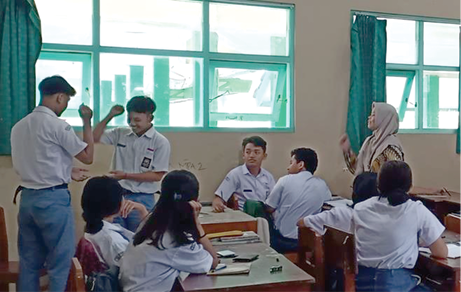
Figure 2 shows students doing a simple simulation to understand the problem. Rock paper scissors can be used as an alternative game to introduce the concept of chance. After introducing the problem, the teacher then asks each group to choose dice or coins. This activity supports content differentiation learning by offering students to explore several contexts related to the material they learn. It was found that 3 groups chose to use dice and 4 groups used coins. The teacher provided references through YouTube and Website to help students in problem solving discussion activities.
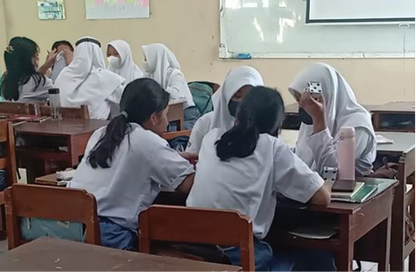
Figure 3 is the condition where students conduct the investigation. The activity that students do during the investigation is to simulate rolling a dice or coin to get a sample point. They also learn to make decisions regarding how to write sample points. Suppose (A, B) represents the number that A got, and B is the number that B got.
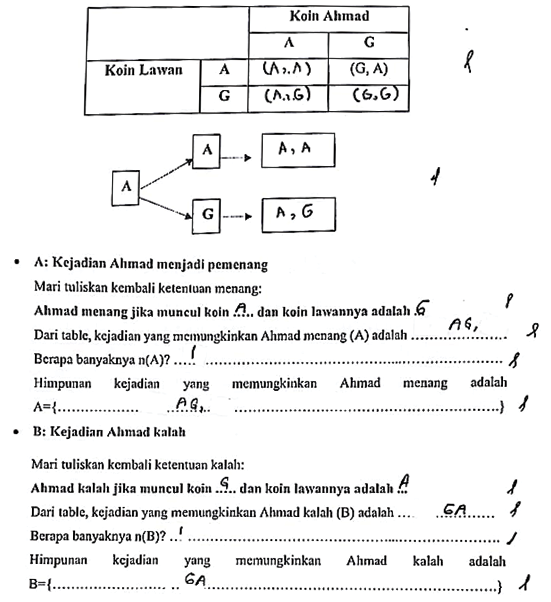
After that, they decide how many times A wins with the applicable conditions and determine the probability. The same thing is done to determine the probability of B winning. At the end of the investigation, they will get the concept that a fair draw is when each person has an equal chance of winning.
The teacher asked the students to display the results of the discussion which was divided into two sessions, namely representatives of the dice group and representatives of the coin group. The teacher then gave reinforcement for the correct answers to the student worksheet, but did not review the material presented.
Observation
Based on observation, the lesson plan was 90% well implemented. Based on the post-test results of students’ computational thinking skills, some students have increased their scores. However, many students who have achieved computational thinking score have not yet reached the success criteria.
|
Computational thinking final score (x) |
Completeness |
Pre-test |
Post-test |
||
|
Frequency |
% |
Frequency |
% |
||
|
x |
|
|
|
|
|
|
x |
|
|
|
|
|
Reflection
After doing reflection towards learning implementation, some evaluations were found related to discipline in discussion activities. During the group discussion, there were some students who were not fully involved in the problem-solving process. The discussion sessions were dominated by students with good computational thinking skills. Thus, other students who have lower abilities were less involved in problem solving.
Evaluation will be taken to improve the next lesson. That improvements made include: bringing process differentiation, where students are grouped based on pre-test results. This grouping is expected to maximize the involvement of each learner in groups with the same ability; the need for time confirmation in discussions and presentations so that not much time is wasted; provide scaffolding according to their individual needs, so that they can build confidence in their ability to solve problems; strengthen the knowledge gained by learners through feedback and provide them with material for notes.
Planning
The things that researchers do during planning are: developing learning tools, observation sheet, and grouping students’ computational thinking ability. To determine the group members, researchers used post-test results in cycle 1. Cycle 2 discusses about compound even probability, especially the probability of event A or B happening. In this cycle, researchers applied process differentiation learning. It refers to the division of groups into three categories of computational thinking ability: high, medium, and low. The student worksheets were differentiated for each category. Low category student worksheets provided some working examples. The medium category students’ worksheets have some clues. While in the high category student worksheets, only the working column is given to explore based on their ideas.
Action
In its application, problem-based learning is carried out with the stages: orienting students, organizing students, guiding investigations and presenting work. The given problem is about the probability of two people taking an item from pencil case.
After given the problem, students were grouped based on the categories that had been prepared. There were 3 groups in high category, 1 group in medium category and 3 groups in low category. In the process, the researcher as a teacher provided different scaffolding based on the ability. The group with low category given more scaffolding than medium group. And in the high category group, the researcher acted as a facilitator and provided help if needed. All groups were able to solve the problem in the given time.
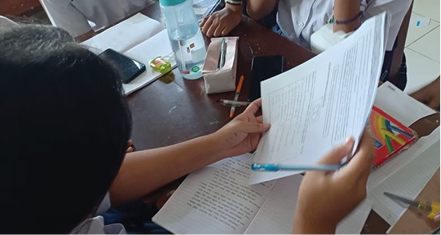
Figure 5 is the situation when the high group is discussing. They asked the teacher more questions to confirm whether the results of their discussion were correct or not.
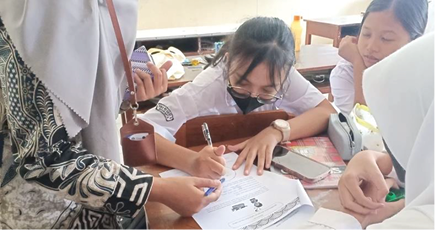
In Figure 6, the medium group needed the teacher’s help to find the concept to be used. Most of them struggled with data analysis.
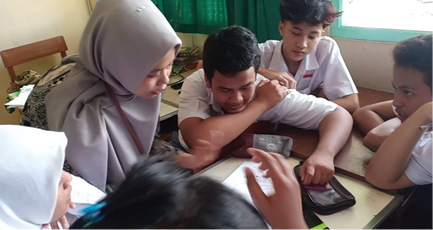
In Figure 7, the teacher must mingle with students to provide understanding related to the problem, guide students to create problem-solving strategies, and analyze data with triggering questions.
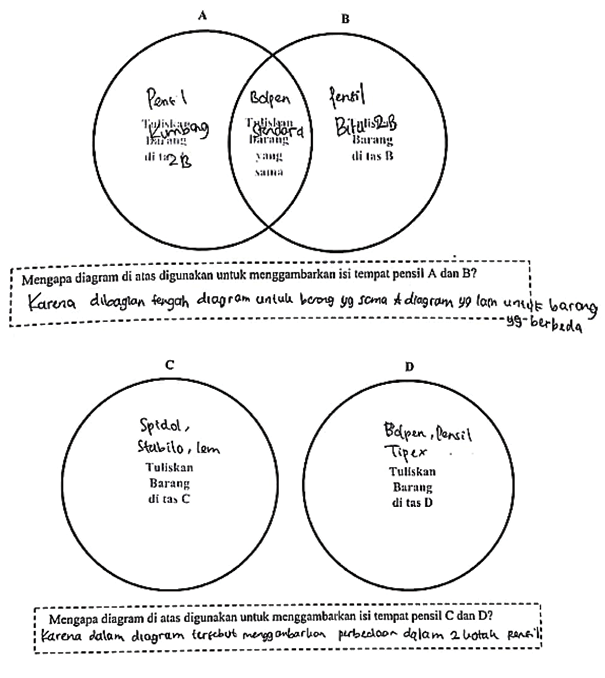
When working on the worksheet, students identified the items from two pencil cases. They recorded the results and represented them in a Venn diagram (Figure 8). Some students drew two intersecting sets and some disjoint sets. The difference in their findings became a topic of class discussion. This led to the concept, through a simple flowchart (Figure 9), that when two events do not have intersection, they are two events that cannot occur at the same time, and conversely, when two events have an intersection, they are two events that can occur at the same time.
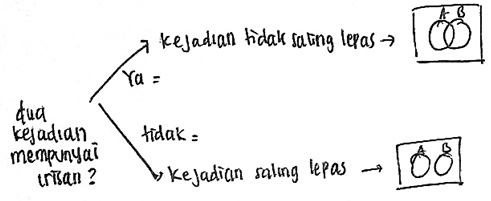
At the end of problem investigation, they were able to find the concept that in random item picking, the existence of intersection decides the probability of item A or item B being picked. They can use the concept to solve the problem of the probability that an item will be taken (Figure 10).
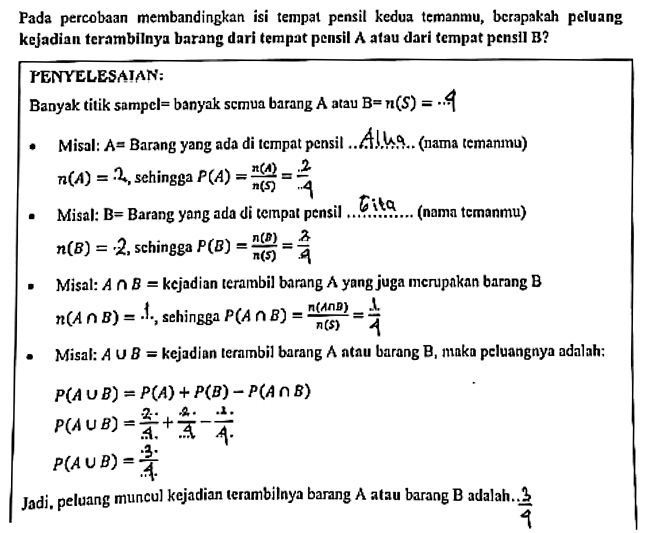
In the presentation activity, the teacher provides equal opportunities for presentation. The teacher then reinforces the results of student discussions and provides material on the blackboard for student notes.
Observation
Based on observation, the lesson plan was 94% well implemented. Based on the post-test results of students’ computational thinking skills, some students have increased their scores. The results showed an improvement in computational thinking skills at the end of cycle 2 when compared to the final score in cycle 1. The percentage of students who have reached the success criteria is more than equal to 75%. The action was completed in cycle 2.
|
Computational thinking final score (x) |
Completeness |
Post-test I |
Post-test II |
||
|
Frequency |
% |
Frequency |
% |
||
|
x |
|
|
|
|
|
|
x |
|
|
|
|
|
Reflection
Reflection from cycle 2 includes class and time management, discussion process and problem-solving pattern. Researchers as teachers have provided clarity regarding time and how activities are carried out. That makes the lesson more effective. In discussion process, homogeneous grouping encouraged them to collaborate with peers of similar ability. Realizing that each group member has the same ability, students worked to complete the worksheet without relying on partner. This grouping is effective enough to make each student feel that they have an equal role and opportunity in learning. The success of cycle 2 is also affected by the students’ familiarity with problem-based learning (because cycle 1 also applied problem-based learning).
Differentiated learning and problem-based learning are two approaches with different goals. Integrating of these approaches can complement and reinforce each other in improving computational thinking skills (unplugged) while reducing the gap in students’ abilities. This is consistent with the results from Dalila et al. (2022), which shows that the differentiated approach (based on learning modalities) in problem-based learning is effective to improve students’ cognitive learning outcomes.
Problem-based learning is an instructional approach that introduces mathematical concepts to students through problem-solving. The use of problem-based learning can improve computational thinking skills, including those commonly used in high school mathematics (Hsu et al., 2018). All aspects of computational thinking are involved in problem solving, namely: abstraction, algorithm, data collection, and data analysis. Probability problems are closely related to sampling points and sampling space. Data collection is often done with dice or coins. Modelling or simulating the problem is basic idea behind computational thinking (Moursund, 2009). These activities enable students to reflect on the results by abstracting and comparing data (Lee et al., 2011). Data analysis in this study involves the processing of data which includes calculations and result interpretations. Various strategies can be applied to analyze data, including pattern recognition, rule-based data classification, and identification (Weintrop et al., 2016). Throughout the project, a well-designed algorithm is used to solve problems. For example, when students are asked to determine the sample point for the sum of two dice of 5, they begin by estimating two numbers that add up to 5. Next, they explore possible arrangements that yield a sum of 5, and so on. In this project, the algorithm is reinforced by a flowchart, which makes it easier for students to understand the concept. Learning using flowcharts can improve both computational thinking skills and self-efficacy, which can lead to an improvement in academic performance (Zhang et al., 2021).
Differentiated learning has a role in improving unplugged computational thinking (Noviyanti et al., 2023; Saxena et al., 2020). It recognizes differences (interests, learning modalities, abilities) and the need for teachers to provide learning opportunities as needed. The application of content differentiation in this study allowed to increase the percentage of students who achieved computational thinking skills exceeding the KKM. When students choose the content (dice/coins), there is an assumption that they are ready to solve the problem. With choice, students encourage themselves to take responsibility for their own learning (Betts, 2004). The improvement in cycle 1 was also influenced by students’ different learning modalities, and it applied in the form of learning references (Web, YouTube, PPT display). Providing personalized learning (learning modality) can improve students’ problem-solving ability, help them to achieve better computational thinking ability and bridging the gap of different students’ skills (Kopeyev et al., 2020; Liu et al., 2021).
In cycle 2, the differentiation of the process by dividing students based on ability also had a good impact on the discussion process and the experience of each student. Based on the observation, when there is a grouping with the same ability, each student has a role in practicing computational thinking skills, without burdening the discussion on the smartest students. This grouping is designed to make it easier for teachers to provide appropriate scaffolding. If in a lesson learning students are given freedom of exploration without scaffolding, then heterogeneous ability grouping is more effective (Linchevski & Kutscher, 1998). Scaffolding is proven to have a positive effect on students’ self-efficacy and learning outcomes (Valencia-Vallejo et al., 2019). In the discussion process, students feel successful when they can solve problems with the help of worksheets and scaffolding from the teacher. This successful feeling makes the discussion atmosphere more comfortable and encourage students to solve problems again and again. In addition, the use of scaffolding can assist students in developing their computational thinking skills during the learning process (Angeli & Valanides, 2020; Lye & Koh, 2014). It’s because the teacher acts as a support system for students to solve their own problems by giving direction so that learning becomes directed and learning goals are achieved (Marchelin et al., 2022). In addition, scaffolding can help and improve the computational thinking process through questions, hints, reminders, directions, or encouragement given until students are able to think computationally optimally when solving math problems (Supiarmo et al., 2021).
Problem-based learning is learning that introduces students to mathematical concepts through problems that exist around them. In problem-based learning, students are faced with a problem that stimulates students’ thinking to analyze the problem, understand it, then solve the problem so that in the end they gain new knowledge. When students analyze the problem, abstraction ability plays a role in it. Where in recognizing the problem, the activity carried out by students is to recognize information which is then taken as an important point to solve the problem. The activity of analyzing problems also allows students to perform algorithms related to the steps or stages that will be used when solving problems. When solving problems, all aspects of computational thinking are involved: abstraction, algorithm, data collection and data analysis. In learning probability, problem-based learning can improve students’ computational thinking skills because of data collection activities in the form of dice/coin simulations, abstraction activities of sample points and important information in the problem, activities to formulate solution steps (algorithms) and data analysis activities in the form of interpretation of results and calculations.
Differentiated learning (content and process) plays a role in improving students’ computational thinking through ability-based scaffolding and content based on their interests and learning modalities. Differentiated learning assumes that each student has different abilities and ways of thinking. For example, not all students interest in coins as a simulation tool, some of them like dice. The teacher can prepare coins and dice so that students can choose the tools that make students interested. Another example is that not all students have good analytical skills. The teacher can make groups based on ability so that assistance is given with the right portion. Through the differentiation approach, students not only develop their computational skills, but also feel valued and supported in their learning process.
The results of this study cannot be generalized to all mathematics classes because it is based on the problems and characteristics of the class that studied. However, problem-based learning can be adapted to improve students’ computational thinking skills by presenting a familiar context and conducting simulations. It is expected that in future research, researchers or teachers as practitioners can adapt or combine the implementation in this study (documentation and explanations in the implementation of this class action can be used as references) with other strategies to improve students’ computational thinking skills. In addition, long-term research is also expected to be able to see the impact.
References
Angeli, C., & Valanides, N. (2020). Developing young children’s computational thinking with educational robotics: An interaction effect between gender and scaffolding strategy. Computers in Human Behavior, 105. https://doi.org/10.1016/j.chb.2019.03.018
Barr, V., & Stephenson, C. (2011). Bringing computational thinking to K-12: What is involved and what is the role of the computer science education community? ACM Inroads, 2(1), 48 - 54. https://doi.org/10.1145/1929887.1929905
Benakli, N., Kostadinov, B., Satyanarayana, A., & Singh, S. (2017). Introducing computational thinking through hands-on projects using R with applications to calculus, probability and data analysis. International Journal of Mathematical Education in Science and Technology, 48(3), 393-427. https://doi.org/10.1080/0020739X.2016.1254296
Betts, G. (2004). Fostering autonomous learners through levels of differentiation. Roeper Review, 26(4), 190-191. https://doi.org/10.1080/02783190409554269
Boud, D., & Feletti, G. (1997). Changing problem-based learning. In The challenge of problem-based learning. (pp. 1-14). Routledge, https://doi.org/10.4324/9781315042039
Dalila, A. A., Rahmah, S., Liliawati, W., & Kaniawati, I. (2022). Effect of Differentiated Learning in Problem Based Learning on Cognitive Learning Outcomes of High School Students. Jurnal Penelitian Pendidikan IPA, 8(4), 1820-1826. https://doi.org/10.29303/jppipa.v8i4.1839
Ghobakhloo, M. (2020). Industry 4.0, digitization, and opportunities for sustainability. Journal of Cleaner Production, 252, . https://doi.org/10.1016/j.jclepro.2019.119869
Grenčíková, A., Kordoš, M., & Navickas, V. (2021). The impact of industry 4.0 on education contents. Business: Theory and Practice, 22(1), 29-38. https://doi.org/10.3846/btp.2021.13166
Grover, S., & Pea, R. (2023). Computational Thinking: A Competency Whose Time Has Come. In Computer Science Education. (pp. 51–68). https://doi.org/10.5040/9781350296947.ch-005
Hsu, T. C., Chang, S. C., & Hung, Y. T. (2018). How to learn and how to teach computational thinking: Suggestions based on a review of the literature. Computers and Education, 126. https://doi.org/10.1016/j.compedu.2018.07.004
Kemmis, S., & McTaggart, R. (1992). The action research planner (3rd ed.). Deakin University Press.
Kopeyev, Z., Mubarakov, A., Kultan, J., Aimicheva, G., & Tuyakov, Y. (2020). Using a personalized learning style and google classroom technology to bridge the knowledge gap on computer science. International Journal of Emerging Technologies in Learning, 15(2), 218–229. https://doi.org/10.3991/ijet.v15i02.11602
Lee, I., Martin, F., Denner, J., Coulter, B., Allan, W., Erickson, J., Malyn-Smith, J., & Werner, L. (2011). Computational thinking for youth in practice. ACM Inroads, 2(1), 32-37. https://doi.org/10.1145/1929887.1929902
Liem, I. (2021, December 16). Computational Thinking dalam Kurikulum Prototipe 2022-2024 (Bagian 1) - Pendidikan. Indonesiana.Id. https://www.indonesiana.id/read/151967/computationalthinking-dalam-kurikulum-prototipe-2022-2024-bagian-1
Linchevski, L., & Kutscher, B. (1998). Tell me with whom you’re learning, and i’ll tell you how much you’ve learned: Mixed-ability versus same-ability grouping in mathematics. Journal for Research in Mathematics Education, 29(5), 533-554. https://doi.org/10.2307/749732
Liu, Y. C., Huang, T. H., & Sung, C. L. (2021). The determinants of impact of personal traits on computational thinking with programming instruction. Interactive Learning Environments, 31(8), 4835-4849. https://doi.org/10.1080/10494820.2021.1983610
Lodi, M., & Martini, S. (2021). Computational Thinking, Between Papert and Wing. Science and Education, 30(4), 883–908. https://doi.org/10.1007/s11191-021-00202-5
Lye, S. Y., & Koh, J. H. L. (2014). Review on teaching and learning of computational thinking through programming: What is next for K-12? Computers in Human Behavior, 41, 51-61 https://doi.org/10.1016/j.chb.2014.09.012
Maharani, S., Kholid, M. N., Pradana, L. N., & Nusantara, T. (2019). Problem solving in the context of computational thinking. Infinity Journal, 8(2), 109-116. https://doi.org/10.22460/infinity.v8i2.p109-116
Marchelin, L. E., Hamidah, D., & Resti, N. C. (2022). Efektivitas Metode Scaffolding dalam MeningkatkanComputational Thinking Siswa SMP pada Materi Perbandingan. Jurnal Pengembangan Pembelajaran Matematika, 3(1), 16-28.
Moursund, D. (2009). Computational Thinking. In IAE-pedia. http://iaepedia.org/Computational_Thinking.
Noviyanti, N., Yuniarti, Y., & Lestari, T. (2023). Pengaruh Pembelajaran Berdiferensiasi Terhadap Kemampuan Computational Thinking Siswa Sekolah Dasar. Prima Magistra: Jurnal Ilmiah Kependidikan, 4(3), 283–293. https://doi.org/https://doi.org/10.37478/jpm.v4i3.2806
OECD. (2020). PISA 2022 Mathematics Framework. https://pisa2022-maths.oecd.org/ca/index.html
Oztemel, E., & Gursev, S. (2020). Literature review of Industry 4.0 and related technologies. Journal of Intelligent Manufacturing, 31(1). https://doi.org/10.1007/s10845-018-1433-8
Resnick, M., Maloney, J., Monroy-Hernández, A., Rusk, N., Eastmond, E., Brennan, K., Millner, A., Rosenbaum, E., Silver, J., Silverman, B., & Kafai, Y. (2009). Scratch: Programming for all. Communications of the ACM, 52(11), 60-67. https://doi.org/10.1145/1592761.1592779
Román-González, M., Pérez-González, J. C., & Jiménez-Fernández, C. (2017). Which cognitive abilities underlie computational thinking? Criterion validity of the Computational Thinking Test. Computers in Human Behavior, 72, 678-691. https://doi.org/10.1016/j.chb.2016.08.047
Saxena, A., Lo, C. K., Hew, K. F., & Wong, G. K. W. (2020). Designing Unplugged and Plugged Activities to Cultivate Computational Thinking: An Exploratory Study in Early Childhood Education. Asia-Pacific Education Researcher, 29(1), 55-66. https://doi.org/10.1007/s40299-019-00478-w
Supiarmo, M. G., Mardhiyatirrahmah, L., & Turmudi, T. (2021). Pemberian Scaffolding untuk Memperbaiki Proses Berpikir Komputasional Siswa dalam Memecahkan Masalah Matematika. Jurnal Cendekia : Jurnal Pendidikan Matematika, 5(1), 368-382. https://doi.org/10.31004/cendekia.v5i1.516
Tomlinson, C. A. (1999) The Differentiated Classroom: Responding to the Needs of All Learners. Alexandria, VA: Association for Supervision and Curriculum Development.
Udvaros, J., Forman, N., & Avornicului, M. S. (2023). Developing computational thinking with microcontrollers in Education 4.0. International Journal of Advanced Natural Sciences and Engineering Researches, 7(4), 103-108. https://doi.org/10.59287/ijanser.563
Weintrop, D., Beheshti, E., Horn, M., Orton, K., Jona, K., Trouille, L., & Wilensky, U. (2016). Defining Computational Thinking for Mathematics and Science Classrooms. Journal of Science Education and Technology, 25(1), 127-147. https://doi.org/10.1007/s10956-015-9581-5
Wing, J. M. (2010). Computational Thinking: What and Why? Thelink - The Magaizne of the Varnegie Mellon University School of Computer Science, March 2006.
Zhang, J. H., Meng, B., Zou, L. C., Zhu, Y., & Hwang, G. J. (2021). Progressive flowchart development scaffolding to improve university students’ computational thinking and programming self-efficacy. Interactive Learning Environments, 31(6), 3792-3809. https://doi.org/10.1080/10494820.2021.1943687
